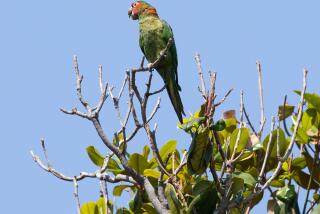Buffet of Bugs Offered to Returning Swallows
- Share via
SAN JUAN CAPISTRANO — Once again, it appears there will be far more tourists than birds here at the annual return of the swallows, an event that draws spectators from around the world.
So city officials and workers at Mission San Juan Capistrano are setting out ladybugs as bird bait in an effort to enhance the festivities that begin early Saturday.
In recent years, so few swallows have swooped into the 221-year-old mission as part of their 7,500-mile migration from Goya, Argentina, that city and mission officials have gone to amusing lengths to entice the birds.
This year, mission employees are sprinkling lacewing larvae, as well as the ladybugs, around the grounds of the edifice built by Father Junipero Serra, hoping some swallows will come for a free lunch.
There wasn’t even a nibble Wednesday, but Holly Franks, an administrative assistant at the mission, wouldn’t give up hope.
“On Swallows Day they will be flying in between these pepper trees,” Franks said confidently.
What’s the matter with these birds--don’t they have any respect for a 68-year-old tradition?
The culprit is urbanization, said Sylvia Gallagher, bird information chairwoman for the Sea and Sage Audubon Society.
“Historically, the mission was the only [structure] around, and it was next to a creek, but now there are lots of bridges and buildings,” she said. The birds, which use mud to build their nests, “are going to find a place next to their mud supply,” she said.
Another factor inhibiting the swallows’ return is the scaffolding put up around the Great Stone Church in 1989. The project, to stabilize the ruins of the church, destroyed by an earthquake in 1812, was extended last year to include the dome area, but the work has discouraged swallows from nesting.
Bird experts say there are countless swallows in Orange County, but fewer are taking up residence at the mission from March to August. Nobody really has numbers to track the decline in swallows at the mission, but the drop has been noticeable.
“I’ve seen them at the mission, but not in the great numbers the Chamber [of Commerce] would lead you to believe,” said Ken Fortune, a member of the South Coast Audubon Society. “I usually see them where there is water.”
A chamber spokesman could not be reached for comment Wednesday.
The paucity of swallows is not expected to dampen Return of the Swallows Day activities scheduled for 7 a.m. Saturday and for March 19, the Feast of St. Joseph. Mission officials expect about 12,000 visitors on the first day and 5,000 the second day.
Swallows Day is taken seriously because it brings crowds of tourists and serves as a symbol for the community of 29,000 people. So it’s not surprising that officials would try almost anything to keep the birds coming.
A few years ago, a craftsman made clay nests and placed them under the mission eaves to attract more birds, but with limited success. This year, as in several previous years, the mission is appealing to the swallows’ stomachs.
Twice a day, at 8:30 a.m. and 4:30 p.m., mission employees empty half a dozen containers crawling with ladybugs. Swallows eat the red-and-black insects in midair.
A second course, considered a delicacy for swallows, is the green lacewing larvae, which employees stash about the grounds. But so far, few birds have built nests.
These days, visitors are more likely to find the birds tucked under nearby freeway underpasses, hanging out under eaves at the Mission Viejo Mall or pestering businesses that don’t want their mess.
But nobody’s giving up on the swallows. In fact, there is modest reason for hope.
Mission docent Alana Jolley said the bird droppings on a cluster of nests outside her office window prove there are some swallows around. “These are empty swallows’ nests,” Jolley said, “but . . . you can tell they have been here.”


